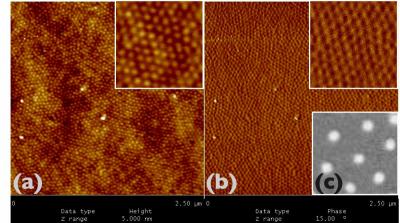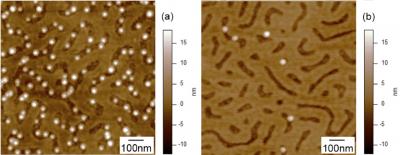Self-Assembly of Nanoparticle Arrays on Block Copolymers
Self-Assembly of Nanoparticle Arrays on Block Copolymers
Sarah Adams
Nanoparticle arrays are useful in current development of molecular biosensors with the capacity for single molecule detection. Field enhanced chemical and biological detection can be achieved through Surface Enhanced Raman Scattering (SERS) associated with closely spaced noble metal nanostructures, with which the surface plasmon resonance is observed as a dipole due to the collective electronegative nature with respect to the positive ionic background. I have used thermodynamically and electrochemically driven self-assembly techniques to synthesize and arrange nanoparticle arrays with preliminary SERS signal enhancement on the order of 107 for single molecule detection. This project aims to develop commercially viable lab-on-chip molecular biosensors using cost efficient bottom-up self-assembly techniques comparable to designs manufactured with costly lithographic methods at nanoscale dimensions. Cost efficient molecular biosensors would be of great use in diagnostic medical applications through SERS measurement for the presence of antibodies and other biological molecules as well as a method to identify the presence of contamination in agricultural materials and water sources. Furthermore this enhanced electrical field design, using the strong scattering from the interacting surface plasmons of metal nanoparticles in a patterned array, is also applicable to enhancement of photovoltaic technology, in which the dipole interactions increase the optical path of incident light in the absorber layers of photovoltaic solar cells.
The polystyrene-b-poly(methyl methacrylate) (PS-b-PMMA) copolymer thin films are fabricated on various substrates to form close packed hexagonal arrays by adapting surface conditions during synthesis. Alternatively, array dimensions and uniformity are also adaptable conditions of self-assembly parameters. Furthermore, surface chemistry techniques are used to functionalize the distinct PMMA regions of the copolymer arrays to form terminating amine groups designed for nanoparticle attachment.
Figure 1. AFM image [(a) topography and (b) phase contrast] of PS-b-PMMA on a PS-r-PMMA/Si surface produces hexagonally packed cylindrical PMMA domains. Phase contrast images show brighter areas in the PMMA regions where elastic modulus is greater. (c) SEM image of Au nanoparticles selectively attached to hexagonal PMMA regions of the diblock copolymer array.
Nanoparticles prepared from colloidal solution can be produced with diverse size, shape, and interfacial features. By using surface chemistry techniques to instigate nanoparticle attachment from colloidal solution, metal nanoparticles with desired physical characteristics can be implemented in template design. For this project, we have adapted nanoparticle synthesis using the Turkevich method in aqueous solution to produce Au nanoparticles of various sizes with which we attach carboxyl organic ligands to selectively bond to the amine groups of the PMMA regions of the diblock copolymer thin films using a chemical crosslinker. With these techniques, we have developed arrays of noble metal nanoparticles having controlled size and shape on a self-organized polymer template.
Figure 2. Amine-treated polymer surface with attached nanoparticles with (a) and without (b) EDC crosslinker treatment. [J. H. Choi, S. M. Adams, and R. Ragan, Nanotechnology, 20, 065301-065306 (2009)]


